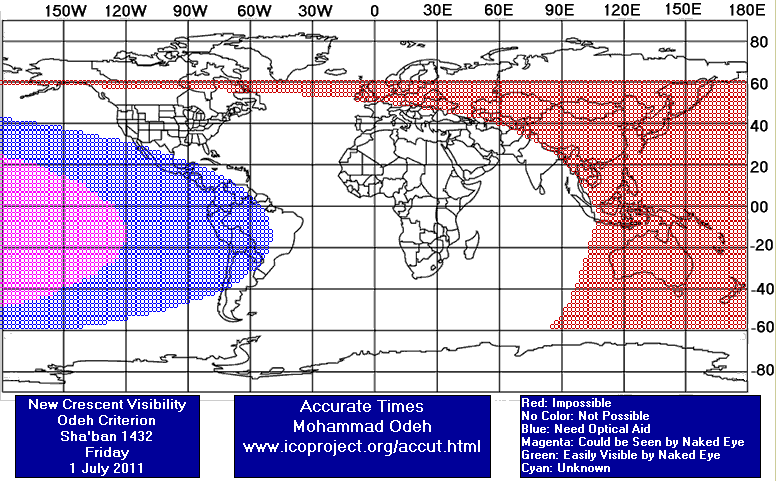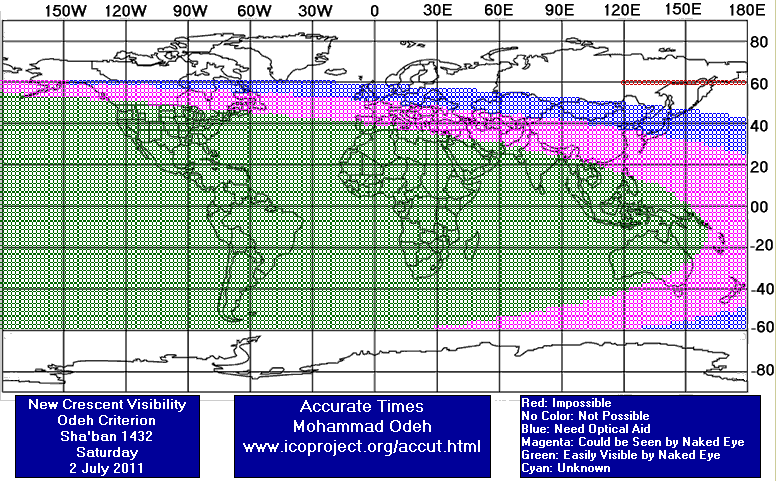Visibility of Sha'ban Crescent 1432 AH
- When to Observe Sha'ban Waxing (NEW) Crescent ?
- Sha'ban Waxing (NEW) Crescent Observation Results
- The OFFICIAL First Day in Different Countries
- When to Observe Rajab Waning (OLD) Crescent ?
- Rajab Waning (OLD) Crescent Observation Results
When to Observe Sha'ban Waxing (NEW) Crescent ?
The geocentric conjunction (Geocentric New Moon) will occur Inshalla on (Friday 01 July 2011) at 08:54 UT.
Sighting the new crescent on (Friday 01 July 2011) and (Saturday 02 July 2011) is shown in the below graphs using the program Accurate Times by Mohammad Odeh according to Odeh criterion. Where:-
- It is impossible to see the crescent from the areas located under the red color. Because either the Moon on this day sets before the Sunset and/or the topocentric conjunction occurs after the Sunset.
- The crescent is expected to be seen by optical aid only from the areas located under the blue color.
- The crescent is expected to be seen by optical aid from the areas located under the magenta color. In these areas the crescent could be seen by naked eye if the atmospheric conditions are superb and the observer is experienced.
- The crescent is expected to be easily visible by naked eye from the areas located under the green color.
- The crescent cannot be seen from uncolored areas, even though the Moon sets in these locations after the Sunset and the topocentric conjunction occurs before the Sunset, but the Moon is not sufficiently illuminated in order to be seen as crescent even by optical aid.
- Kindly notice that the below graph shows the possibility of seeing the crescent from areas between 60 degrees north of Equator down to 60 degrees south of Equator.


According to the Universal Hejric Calendar (UHC), which is based on the calculated crescent visibility, the start of this month in the Eastern Region will be on Sunday 03 July 2011 and in the Western Region will be on Saturday 02 July 2011. Kindly notice that the UHC is a pre-calculated calendar, which adopts a certain criterion to start the new Hejric month. Your country/organization might adopt different criterion to start the new Hejric month. So it is highly advised to read the UHC website before giving any judgment.
- Results of seeing the crescent, and the first day of the month in different countries will be added here Inshalla as we receive the reports from ICOP's members. If you wish to be a member in ICOP, or to know more about it, kindly click here.
Sha'ban Waxing (NEW) Crescent Observation Results
Fri 01 July 2011
Oman
Prof. Mohammed Al-Bussaidi said: "The western horizon was so dusty, hazy and cloudy that we coul not see the Sun almost 25 minutes before it set. As such the crescent was not sighted."
United States
Dr. Javad Torabinejad said: "We arrived at our sighting location at 8:37 pm EDT (sunset: 8:45) and started scanning the NW horizon with naked eye and a pair of binoculars. We stayed there past moonset (moonset: 9:04 pm). Mercury was sighted at 9:01 pm, using the pair of binoculars and later with naked eye."
Mr. Jim Stamm said: "New Moon Crescent Observation Report ====================================== Observed: Friday; July 01, 2011 - 19:45 (Local) Location (WGS 84) = Tucson, Arizona (USA) Longitude = 110.956 W Latitude = 32.385 N Elevation = 811 meters Time Zone = -7.0 hours Surface conditions at location: Temperature = 38 °C Humidity = 07 % Pressure = 29.75 in. Only obvious haze kept the sky from looking perfect. There was subtle banding of high thin cirrus in the west after sunset - contrasted by the red glow. Topocentric and local time values from “Accurate Times”: Sunset (at sea level) = 19:40 Moonset (at sea level) = 20:04 Time from new moon at 19:51 = 18 hr. 26 min. Moon lag time = 24 min. Relative Altitude = 4.5 degrees Elongation from sun = 9.11 degrees Crescent width = 12 arc seconds Illumination = 0.63 percent I was NOT able to see the crescent, even through a telescope. Mercury, Venus and Procyon were easily visible before sunset. Focus and location were almost 100% certain. Observer: Jim Stamm E-mail Address: jimstamm@comcast.net"
Sat 02 July 2011
Australia
Bangladesh
Mr. ABM Ruhul Hassan said: "Due to weather depression the sky was cloudy allover the country. The crescent was not seen anywhere."
Germany
Eng. Martin Elsaesser said: "We met at a nice spot with clear view in all directions, but the moving clouds in the west had fewer gaps than we had hoped and these were always in the wrong places. I brought a CCD-camera with specialized software and tried to monitor the gaps but the crescent was always in the thicker clouds. Inspection of the captured data at home did not show any crescent either. So, despite the large distance of 18° we could not see it."
Ghana
Mr. Abdul-Aziz Anyang said: "According to our counting, today July 02, 2011 is the the 30th day of Rajab 1432 AH. Weather conditions was very cloudy across the whole regional capitals. A call and a report to the northern region (Tamale)this evening after our sunset local time 1818 hrs indicates that the weather is also very very cloudy, hence the first hilal which was expected this evening in Ghana was not seen. Sunday July 03, 2011 is the first day of Shaban 1432 AH."
Iran
Malaysia
Mr. Kassim Bahali said: "Alhamdulillah the hilal was seen by Meade LX200 8" telescope at Al-Khawarizmi Observatory. The western sky was partly couldy and the horizon was hazy. The hilal was seen at 19.50 and then it was covered by cloud at 19.55."
Nigeria
Mr. Qamarudeen Muhammad said: "It is raining here and report from other places indicate cloudiness or raining"
Saudi Arabia
Mr. Saleh Al-Saab said: "The crescent was seen by telescope also by others in difrent locations in the country ."
South Africa
Dr. Abdurrazak Ebrahim said: "Hilaal first sighted by human eye at 18h13 local South African time from my sighting station at the Green Point lighthouse, Cape Town. Sunset: 17.49.36 Moon Altitude: +09°07'46" Moon Azimuth: +299°47'55" Elongation: +15°45'44" Crescent Width: +00°00'36" Illumination: 01.89% Magnitude: -05.55 Crescent shape: 4 o’clock to 10 o’clock The official first day of Shabaan 1432 AH will correspond to Sunday, 3rd July 2011 in South Africa, Lesotho, Swaziland, Botswana, Namibia, Zimbabwe, Malawi, Mozambique, and Angola."
Tanzania
Mr. Zaffar Sheriff said: "The crescent was easily visible just 4 minutes after local sunset."
United Kingdom
Eng. Qamar Uddin said: "On Saturday 2 July 2011 (29 Rajab 1432 AH) many people from throughout UK have attempted to sight the crescent moon (Hilal) of Shaban after sunset. None of the groups were able to sight the Hilal, even though most places had clear sky conditions (see attached photos). However, a fax received from Morocco Awqaf Ministry stated positive Hilal sighting (Muhaqaq-Ruyat-Basari) as well as from other countries including South Africa. Therefore, the Ulama have decided that the month of Rajab 1432 AH will have 29 days and the month of Shaban 1432 AH will start from Sunday 3 July 2011, Insha-Allah. The York group of observers included Maulana Imran Lunat, Vasiullah Bodiyat and Ebrahim Mamaniat from Batley, plus Qamar Uddin and three astronomers from York Astronomical Society."
United States
Dr. Javad Torabinejad said: "We arrived at our sighting location before sunset (sunset: 8:45 pm EDT). The western horizon was partly cloudy and very hazy. Using a pair of binoculars (7X50), I sighted Mercury at 8:56 pm then the crescent, followed by naked eye sighting (my son sighted the moon with naked eye as well). At 9:01 pm the crescent elevation was about 7.5 degrees. We left at 9:20 pm when the moon was still about 4.5 degrees above the horizon (moonset: 9:45 pm EDT)."
Eng. Mohammad Rahman said: "We, 2 persons, have seen the crescent moon with bare eyes from Houston, TX-77079. The sky was clear. So Mahe Lailatun Nisfi Min Sha'aban (Shob e Borat) will be on 16 July 2011 (will be started after sunset of 15 July 2011). "
The OFFICIAL First Day in Different Countries
Fri 01 July 2011
1 . Nigeria
Sat 02 July 2011
1 . Bahrain
2 . Egypt
3 . Jordan
4 . Kuwait
5 . Palestine
6 . Qatar
7 . Saudi Arabia
8 . United Arab Emirates
Sun 03 July 2011
1 . Australia
2 . Ghana
3 . Indonesia
4 . Iran
5 . Malaysia
6 . Mauritius
7 . Morocco
8 . Oman
9 . South Africa
10 . Tanzania
11 . United Kingdom
12 . United States
Mon 04 July 2011
1 . Bangladesh
2 . Pakistan
When to Observe Rajab Waning (OLD) Crescent ?
The geocentric conjunction (Geocentric New Moon) will occur Inshalla on (Friday 01 July 2011) at 08:54 UT.
Sighting the OLD crescent on (Friday 01 July 2011) and on (Thursday 30 June 2011) is shown in the below graphs using the program Accurate Times by Mohammad Odeh according to Odeh criterion. Where:-
- It is impossible to see the OLD crescent from the areas located under the red color. Because either the Moon on this day rises after the Sunrise and/or the topocentric conjunction occurs before the Sunrise.
- The crescent is expected to be seen by optical aid only from the areas located under the blue color.
- The crescent is expected to be seen by optical aid from the areas located under the magenta color.. In these areas the crescent could be seen by naked eye if the atmospheric conditions are superb and the observer is experienced.
- The crescent is expected to be easily visible by naked eye from the areas located under the green color.
- The crescent cannot be seen from uncolored areas, even though the Moon rises in these locations before the Sunrise and the topocentric conjunction occurs after the Sunrise, but the Moon is not sufficiently illuminated in order to be seen as crescent even by optical aid.
- Kindly notice that the below graph shows the possibility of seeing the crescent from areas between 60 degrees north of Equator down to 60 degrees south of Equator.


Rajab Waning (OLD) Crescent Observation Results
Thu 30 June 2011
Iran
Mr. Alireza Mehrani said: "Observation Report Old Crescent = = = = = = = = = = Location: Sardab Village, Fereydounshahr, Esfahan State, Iran Latitude: 32° 50' 16" N Longitude: 50° 01' 26" E Elevation: 2650 meters from sea level Time zone: +4.5 Observer & photographer: Alireza Mehrani Date: Thursday June 30, 2011 (Tir 9, 1390) Topocentric and local time values from "Moon Calculator" at Moonrise time: File name: amehrani-june2011-old.jpg Time: 05:33 LT (01:03 UT) Moon Alt: 5° 37' 44" Sun Alt: - (6° 33' 47") Elongation: 15° 26' 37" Rel Azi: 9° 29' 52" Moon Width: 0.56' Phase: 2.00% Moon Age: 31h 51m before conjunction "





